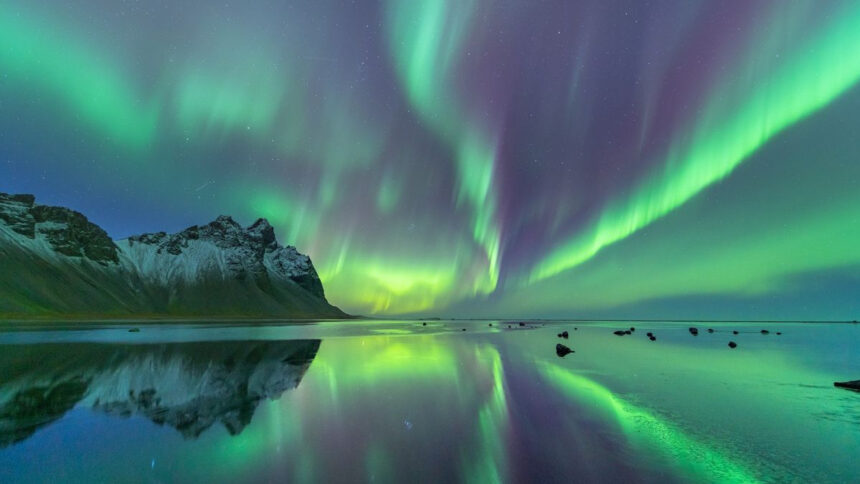For centuries, the Northern Lights have captured the imagination of people around the world. Known scientifically as the Aurora Borealis, this stunning natural phenomenon is a dazzling display of vibrant colors and patterns dancing across the night sky. Most commonly seen near the Arctic Circle in places like Norway, Iceland, and Canada, the Northern Lights have also been observed in more unexpected locations, including parts of the United Kingdom. Recently, stargazers in Suffolk and other areas across the UK were treated to a rare appearance of this ethereal spectacle. This blog explores the origins, science, cultural significance, and best viewing practices for the Northern Lights.
What Are the Northern Lights?
The Northern Lights are caused by interactions between the Earth’s magnetic field and charged particles from the sun. These particles, often referred to as solar wind, are ejected from the sun’s surface during solar storms. When they reach the Earth, they are drawn toward the poles by the planet’s magnetic field. As the particles collide with gases in the Earth’s atmosphere, energy is released in the form of light. This process, known as “auroral emission,” is what creates the beautiful colors and shapes that characterize the Northern Lights.
The most common color seen in auroras is green, which occurs when oxygen atoms high in the Earth’s atmosphere are excited by the incoming solar particles. However, other colors can also appear, depending on the type of gas involved. For instance, nitrogen can produce purple, blue, or pink hues, adding to the Northern Lights’ captivating visual diversity. The patterns in which these lights appear—whether they resemble waves, curtains, or arcs—are determined by the configuration of Earth’s magnetic field lines.
Where and When Can You See the Northern Lights?
Typically, the Northern Lights are most visible in areas close to the Earth’s magnetic poles, such as the Arctic Circle. Countries like Norway, Sweden, Finland, and Iceland are famous for offering some of the best aurora viewing opportunities. However, during periods of heightened solar activity, the Northern Lights can be seen much further south. In rare instances, they have been spotted as far south as the Mediterranean or the southern United States.
Recent sightings in the UK, including Suffolk, Southwold, and even Kent, have surprised and delighted stargazers. These southern appearances are usually brief and faint compared to those seen in the northern latitudes, but they offer a unique opportunity for people who might not otherwise get a chance to witness the aurora in person.
The likelihood of seeing the Northern Lights is closely tied to the solar cycle. The sun goes through an 11-year cycle of activity, oscillating between periods of solar minimum (when there are fewer sunspots) and solar maximum (when sunspot activity is at its peak). As we approach the next solar maximum, expected in 2025, aurora sightings are likely to increase in both frequency and intensity. According to Krista Hammond, a space weather forecaster at the Met Office, the number of auroral displays rises as we get closer to the solar maximum, but the magnitude of each event can vary widely.
The Science Behind the Northern Lights
Lake Windermere tonight… 💚❤️#NorthernLights #AuroraBorealis pic.twitter.com/KcK7bOAWme
— Matt Pounder (@Mattpounder) September 12, 2024Aurora Borealis is a product of a complex interaction between the sun and Earth’s magnetic field. The sun continuously emits a stream of charged particles known as the solar wind. During periods of heightened solar activity, such as solar flares or coronal mass ejections (CMEs), the solar wind intensifies and releases more charged particles into space. Some of these particles travel toward Earth and are funneled into the polar regions by the planet’s magnetosphere.
Once the charged particles reach the Earth’s atmosphere, they collide with atoms of gases such as oxygen and nitrogen. These collisions cause the atoms to become excited, which means they absorb energy and move to a higher energy state. When the atoms return to their normal state, they release this extra energy in the form of light. The type of light produced depends on the type of gas and the altitude at which the collisions occur.
- Oxygen at high altitudes (above 150 miles) produces red auroras, though these are relatively rare.
- Oxygen at lower altitudes (up to 60 miles) emits the more common green auroras.
- Nitrogen can produce purples, blues, and pinks, depending on the type of nitrogen atom and the energy of the collision.
Cultural Significance and Myths Surrounding the Northern Lights
Throughout history, the Northern Lights have been the subject of awe, reverence, and mythology in many cultures. For the Indigenous Sami people of Scandinavia, the aurora was believed to be the souls of the dead dancing in the sky. Similarly, in Finnish folklore, the lights were thought to be caused by a magical fox sweeping its tail across the snow, creating sparks that lit up the sky.
In Inuit culture, the Northern Lights were sometimes seen as the spirits of animals, such as deer, whales, or seals, while some believed they were manifestations of human souls. According to an old Norse legend, the aurora was a reflection of the Valkyries’ armor as they rode to Valhalla, guiding fallen warriors to the afterlife.
Even today, the Northern Lights inspire feelings of wonder and transcendence. Many people consider witnessing the aurora a once-in-a-lifetime experience, something to be checked off their “bucket list.” The beauty of the lights, combined with their rarity and unpredictability, has made them a powerful symbol of nature’s mystery and grandeur.
The Best Conditions for Viewing the Northern Lights
While it is possible to see the Northern Lights without any special equipment, there are several factors that can increase your chances of catching a good display. One of the most important is to find an area with low light pollution. Urban areas, with their abundance of streetlights and illuminated buildings, can drown out the faint glow of the aurora. If you’re hoping to spot the Northern Lights, it’s best to head to rural locations or designated “dark sky” reserves, where artificial light is minimal.
Clear skies are also essential for aurora viewing. Even if the solar activity is strong, a cloudy night can completely obscure the lights. Check weather forecasts in advance to ensure that you’ll have a clear view of the northern horizon.
Timing is another key consideration. The best time to see the Northern Lights is during the winter months when the nights are long and the skies are darker for extended periods. Auroras are typically most active between 9 p.m. and 2 a.m., though this can vary depending on your location and the strength of the solar wind.
Lastly, while the human eye can certainly appreciate the Northern Lights, a good camera can capture even more detail. Cameras are sensitive to a wider range of light wavelengths than the human eye, allowing them to pick up subtle colors and patterns that might otherwise go unnoticed.
How to Photograph the Northern Lights
Witness the mesmerizing Northern Lights over London… I've never seen the Northern Lights myself
All thanks to a solar geomagnetic storm! #NorthernLights #AuroraBorealis pic.twitter.com/QNVRYkWY3S
— Abdullah (@itsabdullah_6) September 12, 2024Capturing the Northern Lights on camera requires a bit of preparation, but the results can be breathtaking. Here are a few tips to help you get the best shots:
- Use a tripod – Since you’ll be shooting in low light, a tripod is essential to keep your camera steady and prevent blurry images.
- Set a long exposure – To capture the full detail of the aurora, set your camera to a long exposure (anywhere from 5 to 30 seconds, depending on the brightness of the lights). This will allow more light to enter the camera, making the aurora appear brighter and more vibrant.
- Use a wide-angle lens – A wide-angle lens will help you capture the full extent of the aurora, especially if it covers a large portion of the sky.
- Set a high ISO – While a high ISO setting can introduce some graininess to your photos, it will also make your camera more sensitive to light, which is crucial for capturing faint auroras.
- Adjust focus manually – In low light, autofocus can struggle to find a subject. Switch to manual focus and set your lens to infinity to ensure that the stars and aurora are in sharp focus.
- Shoot in RAW format – If your camera allows it, shoot in RAW format rather than JPEG. This will give you more flexibility when editing the photos later, especially in terms of adjusting exposure and color balance.
The Future of Aurora Viewing
As we approach the next solar maximum, the frequency of Northern Lights displays is expected to increase. This means more opportunities for stargazers around the world to witness this extraordinary phenomenon. However, there are also some challenges on the horizon.
Climate change, light pollution, and changes in the Earth’s magnetic field could all impact the visibility of the Northern Lights in the future. Warmer temperatures and increased cloud cover in traditionally cold regions could reduce the number of clear nights available for aurora viewing. Meanwhile, expanding urban areas and the increasing use of artificial lighting are making it harder to find dark skies, even in rural areas.
Despite these challenges, the Northern Lights remain one of the most awe-inspiring spectacles in the natural world. Whether you’re a seasoned aurora chaser or someone hoping to catch a glimpse of the lights for the first time, the allure of the Northern Lights is undeniable.
Conclusion
The Northern Lights, with their mesmerizing displays of color and light, are a testament to the beauty and complexity of the universe. While rooted in science, they evoke a sense of magic and wonder that transcends understanding. As solar activity continues to increase in the coming years, there will be more opportunities to witness this natural wonder. So, keep an eye on the night sky, and you may just be lucky enough to see the Northern Lights for yourself. Whether you’re in the Arctic or the southern UK, this is one celestial event you won’t want to miss.
In the meantime, prepare yourself by finding a good location with minimal light pollution, investing in a quality camera or telescope, and staying informed about solar activity.





